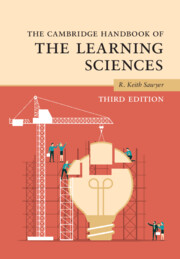104 results
Tables
-
- Book:
- The Cambridge Handbook of the Learning Sciences
- Published online:
- 14 March 2022
- Print publication:
- 07 April 2022, pp x-x
-
- Chapter
- Export citation
Preface
-
-
- Book:
- The Cambridge Handbook of the Learning Sciences
- Published online:
- 14 March 2022
- Print publication:
- 07 April 2022, pp xv-xxii
-
- Chapter
- Export citation
Part VI - Moving Learning Sciences Research into the Classroom
-
- Book:
- The Cambridge Handbook of the Learning Sciences
- Published online:
- 14 March 2022
- Print publication:
- 07 April 2022, pp 579-686
-
- Chapter
- Export citation
Index
-
- Book:
- The Cambridge Handbook of the Learning Sciences
- Published online:
- 14 March 2022
- Print publication:
- 07 April 2022, pp 687-724
-
- Chapter
- Export citation
Part II - Methodologies
-
- Book:
- The Cambridge Handbook of the Learning Sciences
- Published online:
- 14 March 2022
- Print publication:
- 07 April 2022, pp 175-278
-
- Chapter
- Export citation
Copyright page
-
- Book:
- The Cambridge Handbook of the Learning Sciences
- Published online:
- 14 March 2022
- Print publication:
- 07 April 2022, pp iv-iv
-
- Chapter
- Export citation
Figures
-
- Book:
- The Cambridge Handbook of the Learning Sciences
- Published online:
- 14 March 2022
- Print publication:
- 07 April 2022, pp viii-ix
-
- Chapter
- Export citation
33 - The Learning Sciences in the 2020s: Implications for Schools and Beyond
- from Part VI - Moving Learning Sciences Research into the Classroom
-
-
- Book:
- The Cambridge Handbook of the Learning Sciences
- Published online:
- 14 March 2022
- Print publication:
- 07 April 2022, pp 658-686
-
- Chapter
- Export citation
Part V - Learning Disciplinary Knowledge
-
- Book:
- The Cambridge Handbook of the Learning Sciences
- Published online:
- 14 March 2022
- Print publication:
- 07 April 2022, pp 465-578
-
- Chapter
- Export citation
1 - An Introduction to the Learning Sciences
-
-
- Book:
- The Cambridge Handbook of the Learning Sciences
- Published online:
- 14 March 2022
- Print publication:
- 07 April 2022, pp 1-24
-
- Chapter
- Export citation
Part IV - Learning Together
-
- Book:
- The Cambridge Handbook of the Learning Sciences
- Published online:
- 14 March 2022
- Print publication:
- 07 April 2022, pp 383-464
-
- Chapter
- Export citation
Contents
-
- Book:
- The Cambridge Handbook of the Learning Sciences
- Published online:
- 14 March 2022
- Print publication:
- 07 April 2022, pp v-vii
-
- Chapter
- Export citation
Part I - Foundations
-
- Book:
- The Cambridge Handbook of the Learning Sciences
- Published online:
- 14 March 2022
- Print publication:
- 07 April 2022, pp 25-174
-
- Chapter
- Export citation
Contributors
-
- Book:
- The Cambridge Handbook of the Learning Sciences
- Published online:
- 14 March 2022
- Print publication:
- 07 April 2022, pp xi-xiv
-
- Chapter
- Export citation
2 - Foundations of the Learning Sciences
- from Part I - Foundations
-
-
- Book:
- The Cambridge Handbook of the Learning Sciences
- Published online:
- 14 March 2022
- Print publication:
- 07 April 2022, pp 27-52
-
- Chapter
- Export citation
Part III - Grounding Technology in the Learning Sciences
-
- Book:
- The Cambridge Handbook of the Learning Sciences
- Published online:
- 14 March 2022
- Print publication:
- 07 April 2022, pp 279-382
-
- Chapter
- Export citation
Chapter Two - On the Autonomy of Social and Mental Entities: A Paraphrased Translation of ‘Individual and Collective Representations’
-
-
- Book:
- The Anthem Companion to Émile Durkheim
- Published by:
- Anthem Press
- Published online:
- 09 December 2022
- Print publication:
- 05 April 2022, pp 29-50
-
- Chapter
- Export citation

The Cambridge Handbook of the Learning Sciences
-
- Published online:
- 14 March 2022
- Print publication:
- 07 April 2022
26 - Individual and Group Creativity
- from Collaborative Creativity
-
-
- Book:
- The Cambridge Handbook of Creativity
- Published online:
- 12 April 2019
- Print publication:
- 25 April 2019, pp 567-586
-
- Chapter
- Export citation
Chapter 18 - An Interdisciplinary Study of Group Creativity
-
-
- Book:
- The Nature of Human Creativity
- Published online:
- 01 May 2018
- Print publication:
- 19 April 2018, pp 280-290
-
- Chapter
- Export citation

